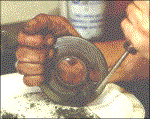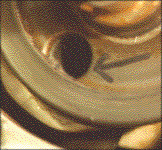
 |
The sludge sticks to a magnet because it contains a lot of ferrous metal from ring and cylinder wear. |
 |
The only way to clean the slingers is to remove the crankshaft from the case and scrape out the slinger groove. You have no choice. |
 |
The arrow in the photo points to the sludge deposit which is migrating down the hollow crank pin hole. This crankshaft had ruined rollers on the rods caused from oil starvation. |